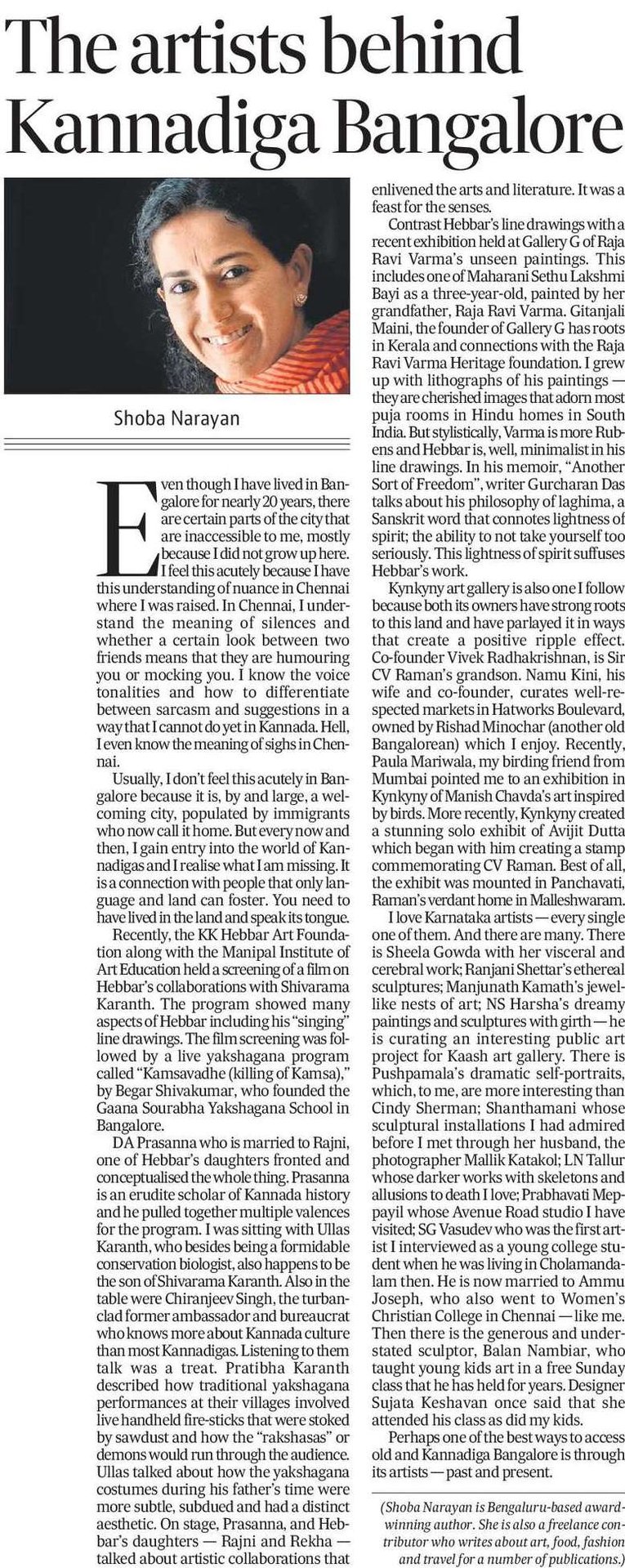Even though I have lived in Bangalore for nearly 20 years, there are certain parts of the city that are inaccessible to me, mostly because I did not grow up here. I feel this acutely because I have this understanding of nuance in Chennai where I was raised. In Chennai, I understand the meaning of silences and whether a certain look between two friends means that they are humouring you or mocking you. I know the voice tonalities and how to differentiate between sarcasm and suggestions in a way that I cannot do yet in Kannada. Hell, I even know the meaning of sighs in Chennai.
Usually, I don’t feel this acutely in Bangalore because it is by and large a welcoming city, populated by immigrants who now call it home. But every now and then, I gain entry into the world of Kannadigas and I realise what I am missing. It is a connection with a people that only language and land can foster. You need to have lived in the land and speak its tongue.
Recently, the K.K. Hebbar Art Foundation along with Manipal Institute of Art Education held a screening of a film on Hebbar’s collaborations with Shivarama Karanth. The program showed many aspects of Hebbar including his “singing” line drawings. The film screening was followed by a live yakshagana program called “Kamsavadhe (killing of Kamsa),” by Begar Shivakumar who founded the Gaana Sourabha Yakshagana School in Bangalore. D. A. Prasanna who is married to Rajni, one of Hebbar’s daughters fronted and conceptualised the whole thing. Prasanna is an erudite scholar of Kannada history and pulled together multiple valences for the program. I was sitting with Ullas Karanth, who besides being a formidable conservation biologist also happens to be the son of Shivarama Karanth. Also in the table were Chiranjeev Singh, the turban-clad former Ambassador and bureaucrat who knows more about Kannada culture than most Kannadigas. Listening to them talk was a treat. Pratibha Karanth described how traditional yakshagana performances at their villages involved live handheld fire-sticks that were stoked by sawdust and how the “rakshasas” or demons would run through the audience, scaring the children. Ullas talked about how the yakshagana costumes during his father’s time were more subtle, subdued and had a distinct aesthetic. On stage, Prasanna, and Hebbar’s daughters—Rajni and Rekha— talked about artistic collaborations that enlivened the arts and literature. It was a feast for the senses.
Contrast Hebbar’s line drawings with a recent exhibition held at Gallery G of Raja Ravi Varma’s unseen paintings including one of Maharani Sethu Lakshmi Bayi as a three-year-old, painted by her grandfather, Raja Ravi Varma. Gitanjali Maini, the founder of Gallery G has roots in Kerala and connections with the Raja Ravi Varma Heritage foundation. I grew up with lithographs of Raja Ravi Varma paintings—they are cherished images that adorn most puja rooms in Hindu homes in South India. But stylistically, Varma is more Rubens and Hebbar is, well, minimalist in his line drawings. In his memoir, “Another Sort of Freedom,” writer Gurcharan Das talks about his philosophy of laghima, a Sanskrit word that connotes lightness of spirit; the ability to not take yourself too seriously. This lightness of spirit suffuses Hebbar’s work.
Kynkyny art gallery is also one I follow because both its owners have strong roots to this land and have parlayed it in ways that create a positive ripple effect. Co-founder Vivek Radhakrishnan, is Sir C. V. Raman’s grandson. Namu Kini, his wife and co-founder, curates well-respected markets in Hatworks Boulevard, owned by Rishad Minochar (another old Bangalorean) which I enjoy. Recently, Paula Mariwala, my birding friend from Mumbai pointed me to an exhibition in Kynkyny of Manish Chavda’s art inspired by birds. More recently, Kynkyny created a stunning solo exhibit of Avijit Dutta which began with him creating a stamp commemorating C.V. Raman. Best of all, the exhibit was mounted in Panchavati, C.V. Raman’s verdant home in Malleshwaram.
I love Karnataka artists—every single one of them. And there are many. There is Sheela Gowda visceral and cerebral work; Ranjani Shettar’s ethereal sculptures; Manjunath Kamath’s jewel-like nests of art; N.S. Harsha’s dreamy paintings and sculptures with girth—he is curating an interesting public art project for Kaash art gallery. There is Pushpamala’s dramatic self-portraits, which, to me, are more interesting than Cindy Sherman; Shanthamani whose sculptural installations I had admired before I met through her husband, the photographer Mallik Katakol; L.N. Tallur whose darker works with skeletons and allusions to death I love; Prabhavati Meppayil whose Avenue Road studio I have visited; S.G. Vasudev who was the first artist I interviewed as a young college student when he was living in Cholamandalam then. He is now married to Ammu Joseph, who also went to Women’s Christian College in Chennai—like me. Then there is the generous and understated sculptor, Balan Nambiar, who taught young kids art in a free Sunday class that he has held for years. Designer Sujata Keshavan once said that she attended his class as did my kids.
Perhaps one of the best ways to access old and Kannadiga Bangalore is through its artists—past and present.
Shoba Narayan is Bangalore-based award-winning author. She is also a freelance contributor who writes about art, food, fashion and travel for a number of publications.



-k4lD-U204025897261YmH-250x250%40HT-Web.jpg)



Well researched article! Great learning! Very absorbing reading!